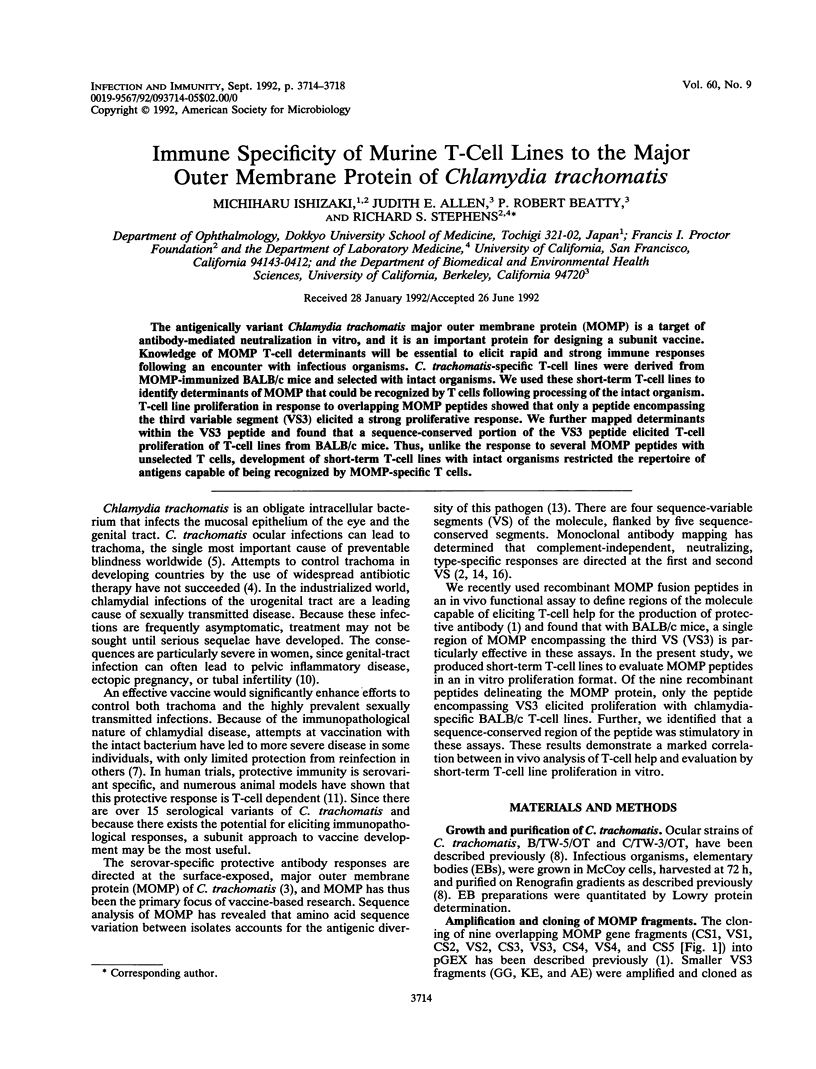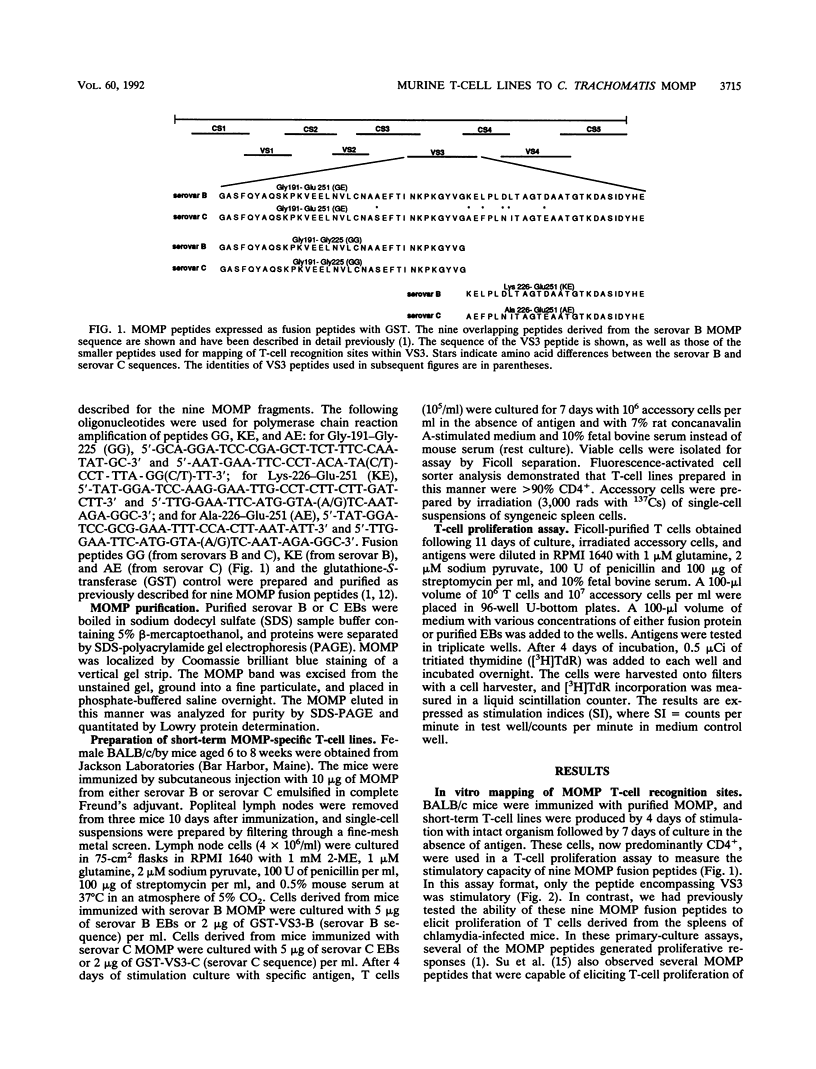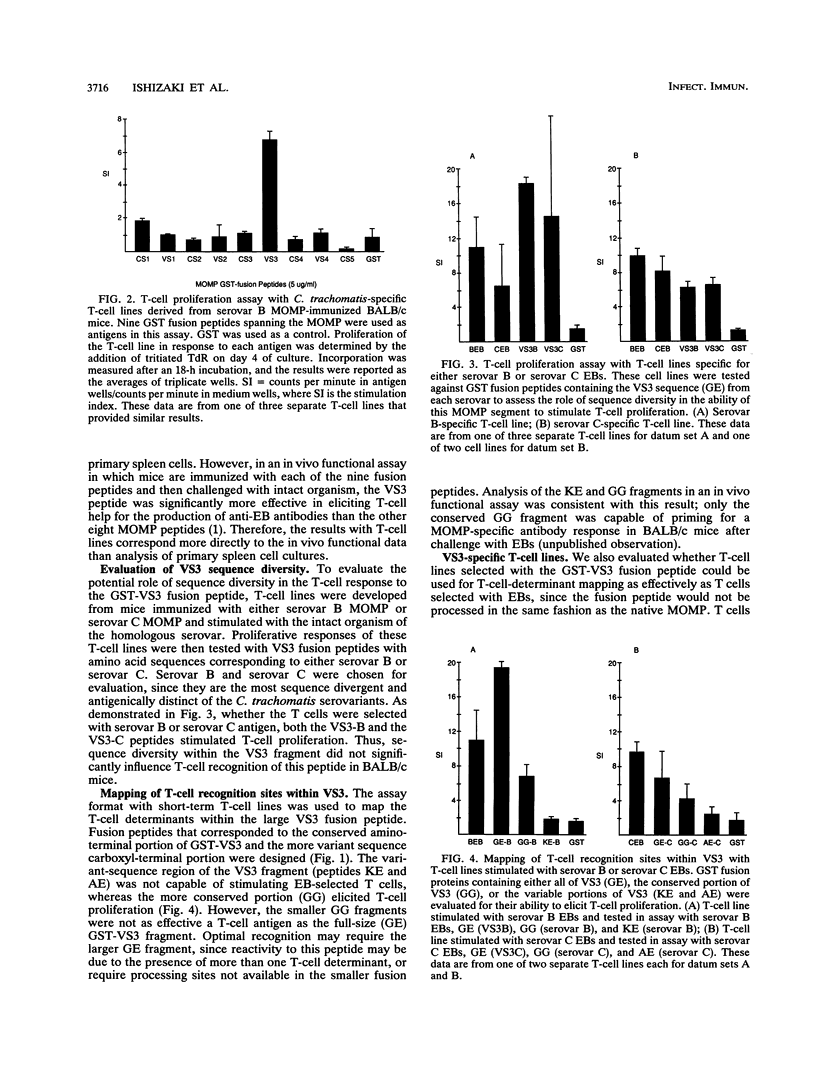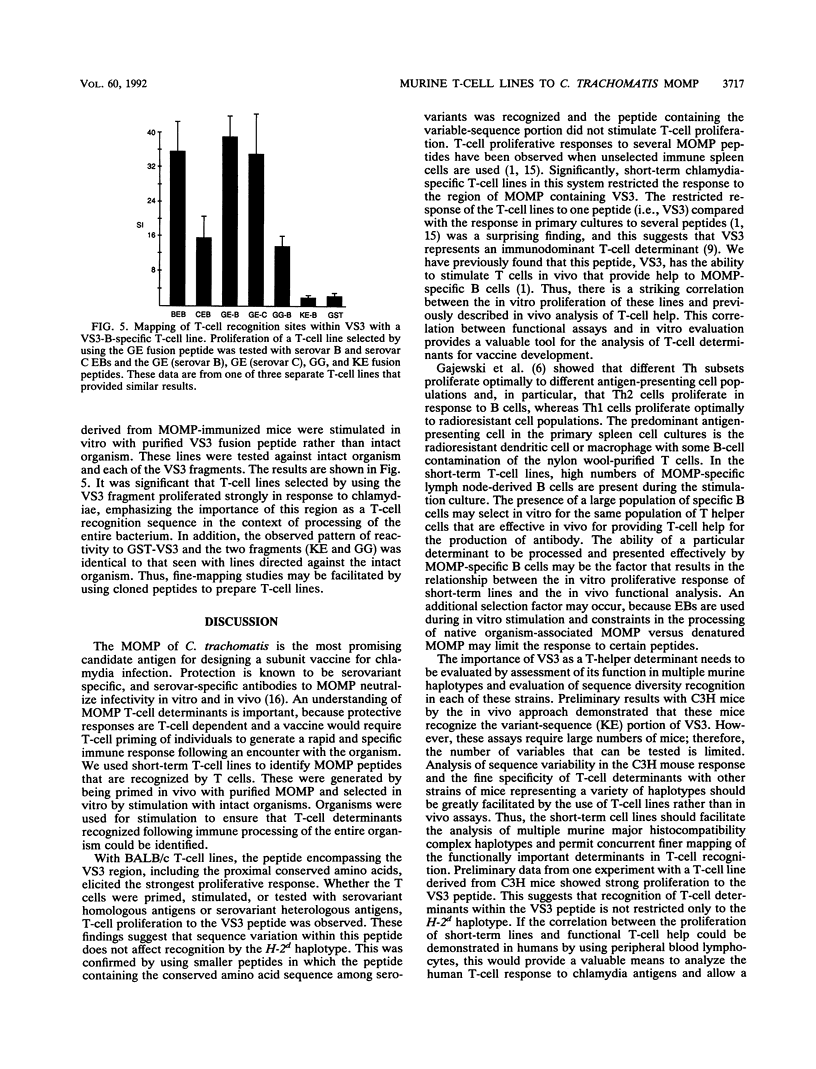Abstract
The antigenically variant Chlamydia trachomatis major outer membrane protein (MOMP) is a target of antibody-mediated neutralization in vitro, and it is an important protein for designing a subunit vaccine. Knowledge of MOMP T-cell determinants will be essential to elicit rapid and strong immune responses following an encounter with infectious organisms. C. trachomatis-specific T-cell lines were derived from MOMP-immunized BALB/c mice and selected with intact organisms. We used these short-term T-cell lines to identify determinants of MOMP that could be recognized by T cells following processing of the intact organism. T-cell line proliferation in response to overlapping MOMP peptides showed that only a peptide encompassing the third variable segment (VS3) elicited a strong proliferative response. We further mapped determinants within the VS3 peptide and found that a sequence-conserved portion of the VS3 peptide elicited T-cell proliferation of T-cell lines from BALB/c mice. Thus, unlike the response to several MOMP peptides with unselected T cells, development of short-term T-cell lines with intact organisms restricted the repertoire of antigens capable of being recognized by MOMP-specific T cells.
Full text
PDF




Selected References
These references are in PubMed. This may not be the complete list of references from this article.
- Allen J. E., Locksley R. M., Stephens R. S. A single peptide from the major outer membrane protein of Chlamydia trachomatis elicits T cell help for the production of antibodies to protective determinants. J Immunol. 1991 Jul 15;147(2):674–679. [PubMed] [Google Scholar]
- Baehr W., Zhang Y. X., Joseph T., Su H., Nano F. E., Everett K. D., Caldwell H. D. Mapping antigenic domains expressed by Chlamydia trachomatis major outer membrane protein genes. Proc Natl Acad Sci U S A. 1988 Jun;85(11):4000–4004. doi: 10.1073/pnas.85.11.4000. [DOI] [PMC free article] [PubMed] [Google Scholar]
- Caldwell H. D., Perry L. J. Neutralization of Chlamydia trachomatis infectivity with antibodies to the major outer membrane protein. Infect Immun. 1982 Nov;38(2):745–754. doi: 10.1128/iai.38.2.745-754.1982. [DOI] [PMC free article] [PubMed] [Google Scholar]
- Courtright P., Sheppard J., Schachter J., Said M. E., Dawson C. R. Trachoma and blindness in the Nile Delta: current patterns and projections for the future in the rural Egyptian population. Br J Ophthalmol. 1989 Jul;73(7):536–540. doi: 10.1136/bjo.73.7.536. [DOI] [PMC free article] [PubMed] [Google Scholar]
- Gajewski T. F., Pinnas M., Wong T., Fitch F. W. Murine Th1 and Th2 clones proliferate optimally in response to distinct antigen-presenting cell populations. J Immunol. 1991 Mar 15;146(6):1750–1758. [PubMed] [Google Scholar]
- Grayston J. T., Wang S. New knowledge of chlamydiae and the diseases they cause. J Infect Dis. 1975 Jul;132(1):87–105. doi: 10.1093/infdis/132.1.87. [DOI] [PubMed] [Google Scholar]
- Li W. F., Fan M. D., Pan C. B., Lai M. Z. T cell epitope selection: dominance may be determined by both affinity for major histocompatibility complex and stoichiometry of epitope. Eur J Immunol. 1992 Apr;22(4):943–949. doi: 10.1002/eji.1830220410. [DOI] [PubMed] [Google Scholar]
- Schachter J. Pathogenesis of chlamydial infections. Pathol Immunopathol Res. 1989;8(3-4):206–220. doi: 10.1159/000157149. [DOI] [PubMed] [Google Scholar]
- Smith D. B., Johnson K. S. Single-step purification of polypeptides expressed in Escherichia coli as fusions with glutathione S-transferase. Gene. 1988 Jul 15;67(1):31–40. doi: 10.1016/0378-1119(88)90005-4. [DOI] [PubMed] [Google Scholar]
- Stephens R. S., Sanchez-Pescador R., Wagar E. A., Inouye C., Urdea M. S. Diversity of Chlamydia trachomatis major outer membrane protein genes. J Bacteriol. 1987 Sep;169(9):3879–3885. doi: 10.1128/jb.169.9.3879-3885.1987. [DOI] [PMC free article] [PubMed] [Google Scholar]
- Stephens R. S., Wagar E. A., Schoolnik G. K. High-resolution mapping of serovar-specific and common antigenic determinants of the major outer membrane protein of Chlamydia trachomatis. J Exp Med. 1988 Mar 1;167(3):817–831. doi: 10.1084/jem.167.3.817. [DOI] [PMC free article] [PubMed] [Google Scholar]
- Su H., Morrison R. P., Watkins N. G., Caldwell H. D. Identification and characterization of T helper cell epitopes of the major outer membrane protein of Chlamydia trachomatis. J Exp Med. 1990 Jul 1;172(1):203–212. doi: 10.1084/jem.172.1.203. [DOI] [PMC free article] [PubMed] [Google Scholar]
- Zhang Y. X., Stewart S., Joseph T., Taylor H. R., Caldwell H. D. Protective monoclonal antibodies recognize epitopes located on the major outer membrane protein of Chlamydia trachomatis. J Immunol. 1987 Jan 15;138(2):575–581. [PubMed] [Google Scholar]


